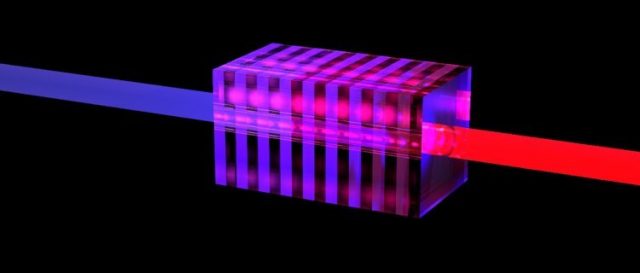Fifty is a critical number for quantum computers capable of solving problems that classic supercomputers cannot solve. Proving quantum supremacy requires at least 50 qubits. For quantum computers working with light, it is equally necessary to have at least 50 photons. And what’s more, these photons have to be perfect, or else they will worsen their own quantum capabilities. It is this perfection that makes it hard to realize. Not impossible, however, which scientists of the University of Twente have demonstrated by proposing modifications of the crystal structure inside existing light sources. Their findings are published in Physical Review A.
Photons are promising in the world of quantum computing, with its demands of entanglement, superposition and interference. These are properties of qubits, as well. They enable building a computer that operates in a way that is entirely different from making calculations with standard bits that represent ones and zeroes. For many years now, researchers have predicted quantum computers able to solve very complex problems, like instantly calculating all vibrations in a complex molecule.
The first proof of quantum supremacy is already there, accomplished with superconducting qubits and on very complicated theoretical problems. About 50 quantum building blocks are needed as a minimum, whether they are in the form of photons or qubits. Using photons may have advantages over qubits: They can operate at room temperatures and they are more stable. There is one important condition: the photons have to be perfect in order to get to the critical number of 50. In their new paper, UT scientists have now demonstrated that this is feasible.
Throwing away part of the photon
But what is a “perfect photon,” anyway? The photon light source may be lossy, in which case, an expected photon will not appear. But you could also lose a photon—and thus the computing outcomes—moving through a set of light-conducting channels for quantum calculations. The main cause of imperfection, however, is that the light source produces photons that are each slightly different, when they should be exactly the same. Imagine a photon pair that comes out of the light source, of which one is red and the other is a bit more orange. They have much, but not enough, in common. Using a filter to make them both red seems obvious. But you will lose part of the photon, thus making quantum calculations impossible, as the imperfections remain coupled. Even in a system that can deal with some imperfection, the critical number of 50 is never reached, and off goes supremacy.
Find your dream job in the space industry. Check our Space Job Board »
Crystal domains
The researchers went back to basics—to the light source, to determine if there is room for improvement. They wanted to improve the crystal structure of the light source. By playing with the preferred orientation in the crystals and by dividing them into domains, it was possible to produce light with the desired properties. For some years now, researchers have been working on fixed domains. Varying the domains, however, is required for better tailoring of the light properties. In many labs around the world, researchers are studying this method of manipulating light. This new publication adds a new way of optimizing the crystal by approaching the realization of perfect photons.
Provided by: University of Twente
More information: R. van der Meer et al. Optimizing spontaneous parametric down-conversion sources for boson sampling, Physical Review A (2020). DOI: 10.1103/PhysRevA.101.063821
Image Credit: University of Twente











